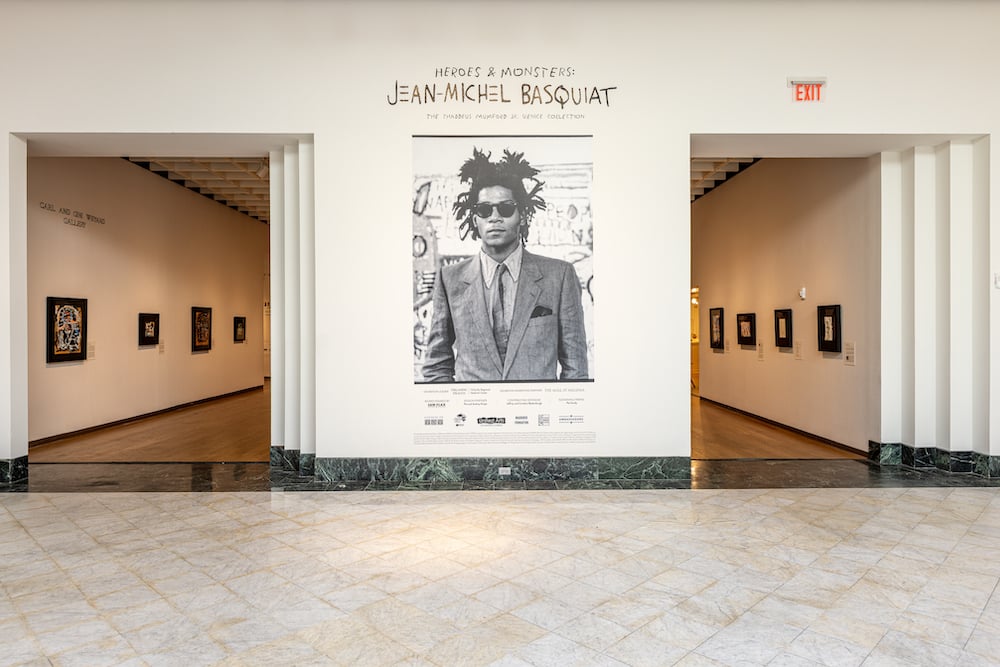
Visitors attending an Jean-Michel Basquiat exhibition at the Orlando Museum of Art on Friday were quickly whisked off the premises, as a group of F.B.I agents entered the galleries and began removing the works from the wall.
All 25 paintings were seized by authorities after questions were raised about their authenticity since the show’s opening in February. The 41-page affidavit for the search warrant presented to the museum by the F.B.I., which was seen by the New York Times, focused on the works’ questionable provenance, saying its investigations revealed “false information relating to the alleged prior ownership of the paintings.”
In a statement, a spokeswoman for the museum said, “it is important to note that we still have not been led to believe the Museum has been or is the subject of any investigation.” She added, “we continue to see our involvement purely as a fact witness.”
The works, which are currently owned by the dealer William Force and his financial backer Leo Mangan, are said to have been produced in 1982, when Basquiat lived in a studio beneath Larry Gagosian’s Los Angeles home and was preparing for a show at his gallery in the city. The artist apparently sold these works directly to the late screenwriter Thad Mumford for $5,000.
As the story goes, Mumford kept the works in a storage unit for 30 years until 2012, when late rent payments led to its contents being seized and put up for auction. The 25 works were apparently spotted by Force, who paid $15,000 for them.
Larry Gagosian told the New York Times that this series of events was “highly unlikely” and Basquiat’s studio assistant John Seed said he has no recollection of the works. Mumford, who died in 2018, signed an 2017 affidavit in the presence of F.B.I. agents stating “at no time in the 1980s or at any other time did I meet with Jean-Michel Basquiat, and at no time did I acquire or purchase any paintings by him,” according to the New York Times.
Installation view of the “Heroes & Monsters: Jean-Michel Basquiat, The Thaddeus Mumford, Jr. Venice Collection” at the Orlando Museum of Art, 2022. Courtesy of the OMA.
Over the past decade, the works have failed to sell on the secondary market. “These fake works have been around for some time and I’ve been aware of them,” the art advisor Todd Levin told Artnet News. “By quick visual inspection, they are immediately problematic. It’s clear to anybody who has expertise about Basquiat’s oeuvre—built up from decades of experience handling it, dealing with it, looking at it, and having known the artist—that these are, without a doubt, not by the artist.”
The F.B.I’s affidavit also reportedly refers to “attempts to sell the paintings using false provenance, and bank records show possible solicitation of investment in artwork that is not authentic.”
Efforts to prove the authenticity of the works, which could be worth as much as $100 million of they were real, include an analysis of the signature by handwriting expert James Blanco in 2017 and, in the same year, an authentication of 16 of the works by Jordana Moore Saggese, an associate professor of art at the University of Maryland and author of a book on Basquiat. Saggese later tried to distance herself from the works, according to the New York Times, saying the owners had misrepresented her findings and removed pages from her report that stated nine of the works could not be attributed to Basquiat.
A showing at a major public museum would have lent the works additional legitimacy. When Levin heard about about the exhibition in Florida, he attempted to get in touch with the museum’s director Aaron de Groft and the board, but received no response. “At that point I contacted the F.B.I.,” he says
A report by the New York Times revealed that the typeface that appeared on the cardboard FedEx box used for one work can be dated to several years after the artist’s death. The design expert Lindon Leader, who redesigned FedEx’s logo, recognized the Univers 67 Bold Condensed typeface on the painting’s reverse, which he said was only used on the shipping company’s packaging after 1994.
“When that fact came to light, the show should have come down immediately,” Levin said.
The exhibition, titled “Heroes and Monsters”, was due to close June 30 before traveling to Italy. “A show like this, with supposedly unknown, unseen works by Basquiat would be a tremendous financial gain for any museum,” Levin said. “The fact that there wasn’t one U.S. institution that had inquired and arranged to travel this show prior to the F.B.I. investigation speaks silent volumes.”